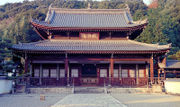
Mampuku-ji
Encyclopedia

Temple
A temple is a structure reserved for religious or spiritual activities, such as prayer and sacrifice, or analogous rites. A templum constituted a sacred precinct as defined by a priest, or augur. It has the same root as the word "template," a plan in preparation of the building that was marked out...
located in Uji, Kyoto
Uji, Kyoto
is a city on the southern outskirts of the city of Kyoto, in Kyoto Prefecture, Japan. Founded on March 1, 1951, Uji is located between the two ancient capitals of Nara and Kyoto. The city sits on the Uji River, which has its source in Lake Biwa. As of April 1, 2008, Uji has an estimated population...
. It is the head temple of the Japan
Japan
Japan is an island nation in East Asia. Located in the Pacific Ocean, it lies to the east of the Sea of Japan, China, North Korea, South Korea and Russia, stretching from the Sea of Okhotsk in the north to the East China Sea and Taiwan in the south...
ese Ōbaku
Obaku (school of Buddhism)
The , is , one of three sects of Zen in Japanese Buddhism.-History:Often termed the third sect of Zen Buddhism in Japan, it was established in 1661 by a small faction of masters from China and their Japanese students at Manpuku-ji in Uji, Japan.Today Manpuku-ji serves as the Ōbaku's head temple,...
Zen
Zen
Zen is a school of Mahāyāna Buddhism founded by the Buddhist monk Bodhidharma. The word Zen is from the Japanese pronunciation of the Chinese word Chán , which in turn is derived from the Sanskrit word dhyāna, which can be approximately translated as "meditation" or "meditative state."Zen...
sect
Schools of Buddhism
Buddhism is an ancient, polyvalent ideological system that originated in the Iron Age Indian subcontinent, referred to variously throughout history by one or more of a myriad of concepts – including, but not limited to any of the following: a Dharmic religion, a philosophy or quasi-philosophical...
, named after Wanfu Temple
Wanfu Temple
Wanfu Temple is a temple on Mount Huangbo in Fujian province, China. It is famous as the original temple of Yinyuan Longqi, the temple's 33rd abbot and a Chan master...
in Fujian, China. The mountain is likewise named after Mount Huangbo
Mount Huangbo
Mount Huangbo is a mountain in Fuqing, Fujian province, China. It is famous for its temples, including:*Wanfu Temple...
, where the Chinese temple is situated.
History
The temple was founded in 1661 by the Chinese monk Yinyuan Longqi (Ingen) and his disciple MuyanMuyan
Muyan was a Chinese Chan monk who followed his master Yinyuan Longqi to Japan in 1654....
.
In 1664 control of the temple passed to Muyan
Muyan
Muyan was a Chinese Chan monk who followed his master Yinyuan Longqi to Japan in 1654....
, after many Chinese monks followed as head priests. Only the fourteenth priest and his successors are Japanese.
- May 21, 1673 (Enpō 1, 5th day of the 4th month): Yinyuan (Ingen) dies here.
Architecture

Ming Dynasty
The Ming Dynasty, also Empire of the Great Ming, was the ruling dynasty of China from 1368 to 1644, following the collapse of the Mongol-led Yuan Dynasty. The Ming, "one of the greatest eras of orderly government and social stability in human history", was the last dynasty in China ruled by ethnic...
style.
The arrangement of buildings also follows Ming Dynasty architectural style, representing an image of a dragon.
Art
The temple treasure house contains a complete collection of Buddhist scriptures completed in 1678 and comprising approximately 60,000 printing blocks, which are still in use. The production of the printing blocks was funded by donations collected throughout the country for many years.The temple's main statue is a seated Gautama Buddha
Gautama Buddha
Siddhārtha Gautama was a spiritual teacher from the Indian subcontinent, on whose teachings Buddhism was founded. In most Buddhist traditions, he is regarded as the Supreme Buddha Siddhārtha Gautama (Sanskrit: सिद्धार्थ गौतम; Pali: Siddhattha Gotama) was a spiritual teacher from the Indian...
.
Sculptures by the Chinese sculptor known as Han Do-sei and latticed balustrades can also be seen.
See also
- Japanese Buddhism
- ZenZenZen is a school of Mahāyāna Buddhism founded by the Buddhist monk Bodhidharma. The word Zen is from the Japanese pronunciation of the Chinese word Chán , which in turn is derived from the Sanskrit word dhyāna, which can be approximately translated as "meditation" or "meditative state."Zen...
- Egoku DōmyōEgoku DomyoEgoku Dōmyō was an Ōbaku priest, ordained at the age of nine into the Rinzai sect. In 1650 he met Tao-che—the Abbot of Sofuku-ji—in Nagasaki, Japan and subsequently joined his temple. Later he joined the assembly at Mampuku-ji in 1663, following the death of Tao-che. There he trained under his...
- Glossary of Japanese BuddhismGlossary of Japanese BuddhismThis is the glossary of Japanese Buddhism, including major terms the casual reader might find useful in understanding articles on the subject. Words followed by an asterisk are illustrated by an image in one of the photo galleries...
-- explanation of terms concerning Japanese Buddhism, Japanese Buddhist art, and Japanese Buddhist temple architecture

